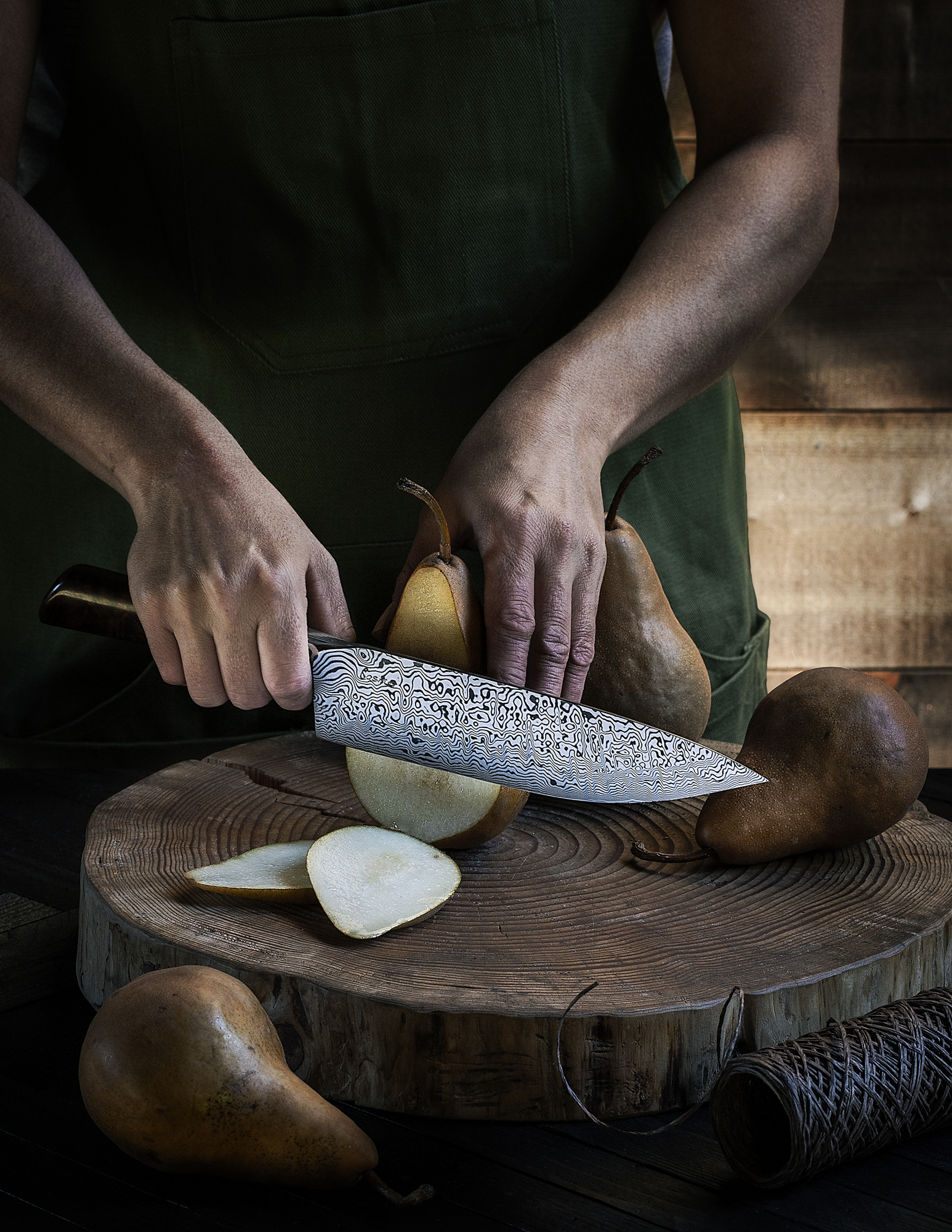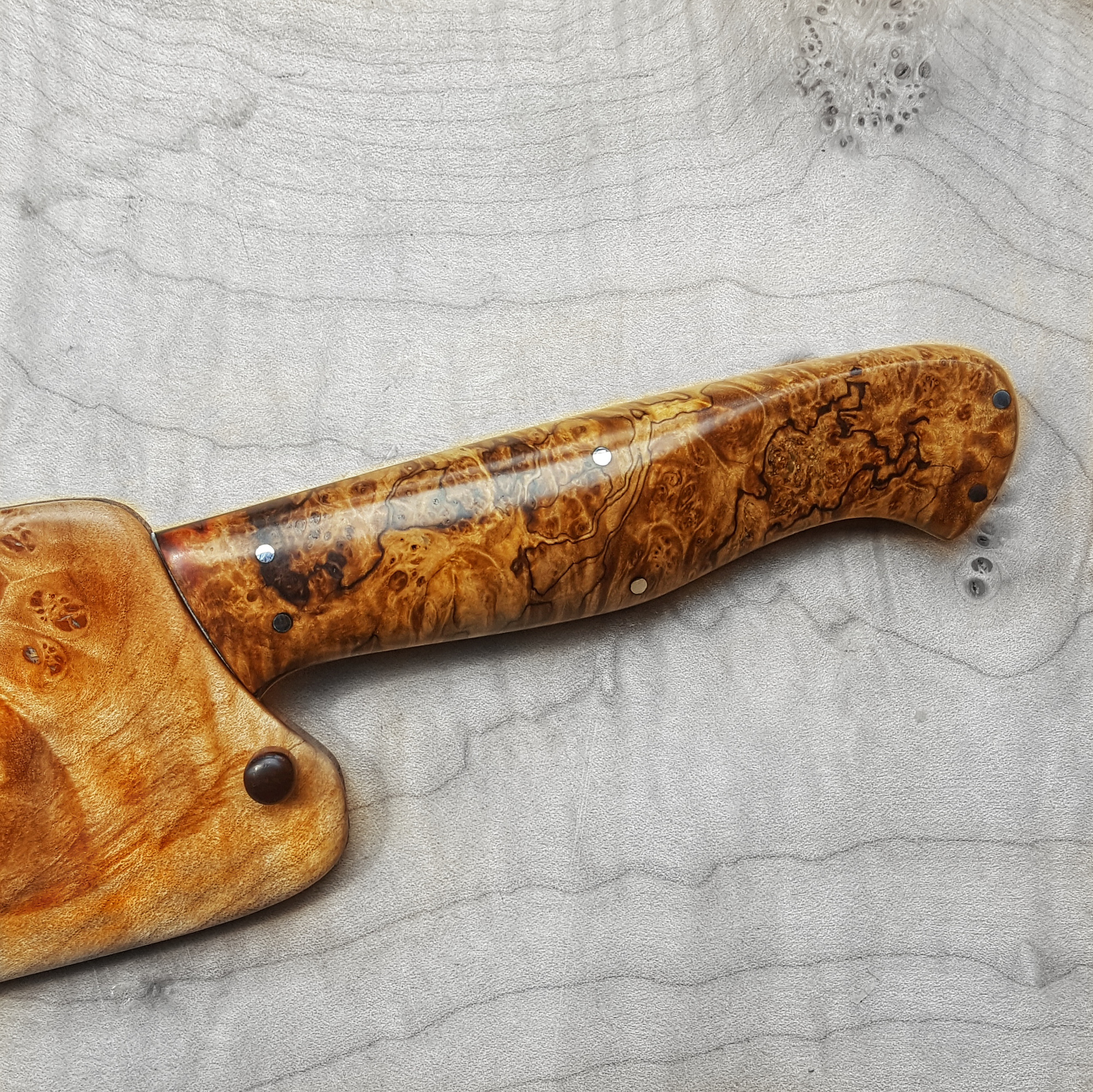Crafting the Ultimate Blade
Humans’ relationship to the cutting edge of steel goes back millennia. But despite these thousands of years of experience, custom knife makers today are still on the quest to craft the ultimate blade, with a renewed interest in bladesmithing having caught fire among a new generation of artisans.

The art of making knives
Vancouver Island bladesmiths are creating products that elevate the knife to a work of art. Seth Burton of Cosmo Knives forges his own Damascus-style blades on Salt Spring Island and makes every element of the finished knife by hand—right down to the threaded steel pins. He was drawn to the craft because it requires working with a diversity of materials, and he takes pride in producing “an exquisite, functional piece of art that people can use every day.”
The draw for Aaron Virag from Zoltan Blades in Tofino is the creative outlet that knife making provides. “Making something with your hands that works better than something that you can buy at the store is incredibly satisfying.” Virag also incorporates the ripple effect of Damascus in much of his work and strives to use local, recycled steel where possible. He echoes Burton’s value in creating something completely unique: “With a handcrafted knife, the maker has an opportunity to design and build something that may be quite different from what is offered in a store.”
Scott Laughlin of Sandstorm Custom Knives in Campbell River started crafting blades more than 35 years ago after cutting himself badly with a poorly designed knife. He couldn’t afford a custom knife, so he set to learning how to make his own. “Balance is very key,” he says. “You need to feel you can use it all day long if that was your job. Comfortable in the hand but at the same time, strong enough to do its purpose without breaking.”
These talented Island bladesmiths are dedicated to solving the ultimate equation: how do you make the strongest blade, with the sharpest edge, using the lightest material, that requires the least amount of maintenance? Negotiating those elements is a lifelong practice, but one that bladesmiths revel in throughout their personal quest to make the perfect knife.
.jpg)

Selecting a knife
Burton explains that there are four primary factors to consider when selecting a great knife: overall quality, fit and finish, balance and weight, and the general feel of the knife in your hand. “In a world of mass production and one-size-fits-all, people are looking for something unique, made with care, attention to detail and precision.”
Virag adds that personal preference and diet play a huge factor in selecting your favourite knife. “I eat a lot of vegetables, so a nakiri is the knife I use the most. Some people use a standard chef knife for everything, and some people, like my mother, only use a paring knife. Understanding what your needs are will help you better select a proper knife.”
An 8-inch chef’s knife is a stalwart tool that will be up to most tasks, but if you’re looking to expand beyond one tool in your belt, Laughlin offers another alternative: “The santoku style has a blade tip that curves down like the head of an orca. I make them with a grind only on one side. It’s phenomenal in the kitchen.”

When you’re assessing the overall fit of a potential knife, it’s also helpful to think about how it might feel after an entire day’s work. Many chefs develop blisters on their hands from repeated motions, so paying attention to pain points is vital in selecting the best fit.
Traditional French cuisine often involves turning the vegetables, so in a classic French Brigade kitchen you’d find an arsenal of kitchen weaponry at the ready, a different knife for each task. Now, especially within the landscape of farm-to-table trends and an emphasis on minimizing food waste, you’ll see a lighter touch from the chef’s knife and fewer tools in their knife roll. A typical North American diet enables the keen home cook to invest in one or two quality blades that should last a lifetime.
‘Beauty inspires beauty’
 When you consider the passion that artisans like Burton, Laughlin and Virag bring to the table (or forge, as it were), the energy you feel when holding a knife that’s been handcrafted is almost palpable. The knife is a canvas that requires multiple levels of skill and ultimate precision, and when you handle natural materials like sustainably-sourced maple burl carved into a comfortable seven-sided heptagon as with Burton’s signature handle, you can see how the natural beauty of the West Coast is steeped into the design of these products.
When you consider the passion that artisans like Burton, Laughlin and Virag bring to the table (or forge, as it were), the energy you feel when holding a knife that’s been handcrafted is almost palpable. The knife is a canvas that requires multiple levels of skill and ultimate precision, and when you handle natural materials like sustainably-sourced maple burl carved into a comfortable seven-sided heptagon as with Burton’s signature handle, you can see how the natural beauty of the West Coast is steeped into the design of these products.
“Our environment has a large impact on us; beauty inspires beauty,” notes Virag. And if you need any more inspiration to invest in your own custom blade, Virag’s testament to the ultimate joy of knifemaking is “hearing back from a customer that the piece I made was the nicest gift the recipient ever received. That lights me up every time.”




